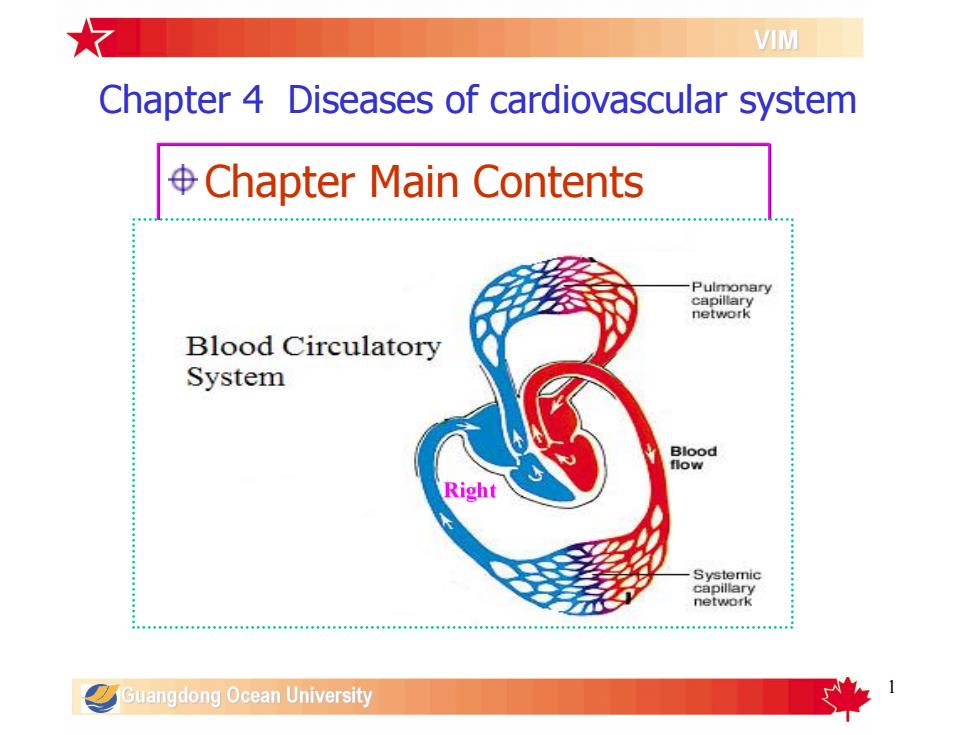
VIMChapter 4 Diseases of cardiovascular system$ChapterMainContentsPulmonarycapillarynetworkBlood CirculatorySystemBloodflowRightSystemiccaplllanynetworkGuangdong Ocean University
1 Chapter 4 Diseases of cardiovascular system Chapter Main Contents • Conspectus • Section 1 Acute heart failure • Section 2 Traumatic pericarditis
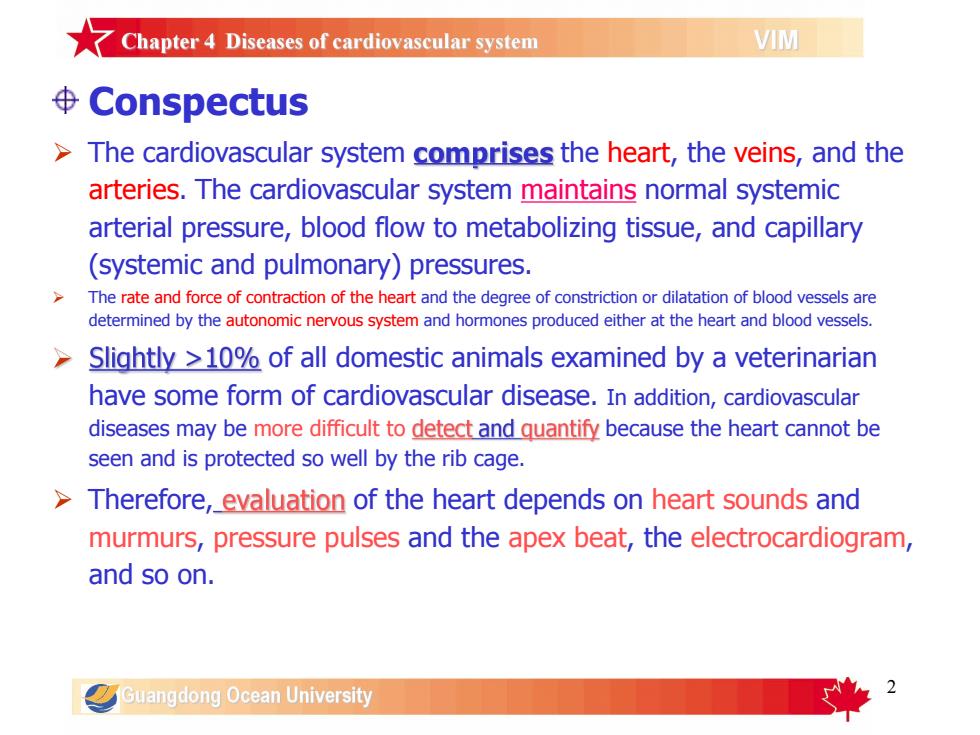
Chapter4Diseases of cardiovascularsystemVIM$Conspectus> The cardiovascular system comprises the heart, the veins, and thearteries.The cardiovascular system maintains normal systemicarterial pressure,bloodflowtometabolizing tissue,and capillary(systemicandpulmonary)pressures.The rate andforce of contraction of the heart and the degree of constriction ordilatation of blood vessels aredetermined by theautonomic nervous system and hormones produced either at theheart and blood vessels.Slightly >10% of all domestic animals examined by a veterinarianhave someform of cardiovascular disease.In addition, cardiovasculardiseases may be more difficult to detect and quantify because the heart cannot beseen and is protected so well by the rib cage.>Therefore,evaluationof theheartdepends onheartsoundsandmurmurs, pressure pulses and the apex beat, the electrocardiogram,and so on.Guangdong Ocean University
2 Conspectus Ø The cardiovascular system the heart, the veins, and the arteries. The cardiovascular system maintains normal systemic arterial pressure, blood flow to metabolizing tissue, and capillary (systemic and pulmonary) pressures. Ø The rate and force of contraction of the heart and the degree of constriction or dilatation of blood vessels are determined by the autonomic nervous system and hormones produced either at the heart and blood vessels. of all domestic animals examined by a veterinarian have some form of cardiovascular disease. In addition, cardiovascular diseases may be more difficult to because the heart cannot be seen and is protected so well by the rib cage. Ø Therefore, of the heart depends on heart sounds and murmurs, pressure pulses and the apex beat, the electrocardiogram, and so on
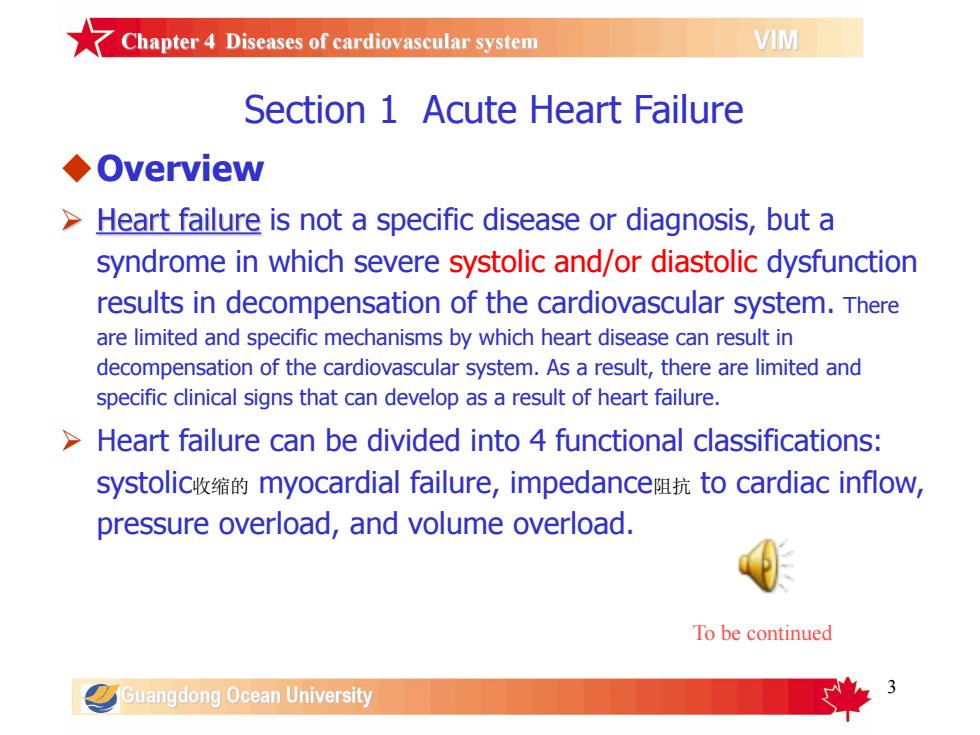
Chapter 4Diseases of cardiovascular systemVIMSection1AcuteHeartFailureOverviewHeart failure is not a specific disease or diagnosis,but asyndrome in which severe systolic and/or diastolic dysfunctionresults in decompensation of the cardiovascularsystem.Thereare limited and specific mechanisms by which heart disease can result indecompensation of thecardiovascular system.As aresult, there are limited andspecific clinical signs that can develop as a result of heart failure.> Heart failurecan be divided into 4functional classificationssystolic收缩的myocardial failure,impedance阻抗to cardiac inflow,pressure overload, and volume overload.To be continuedGuangdong Ocean University
3 Section 1 Acute Heart Failure uOverview is not a specific disease or diagnosis, but a syndrome in which severe systolic and/or diastolic dysfunction results in decompensation of the cardiovascular system. There are limited and specific mechanisms by which heart disease can result in decompensation of the cardiovascular system. As a result, there are limited and specific clinical signs that can develop as a result of heart failure. Ø Heart failure can be divided into 4 functional classifications: systolic收缩的 myocardial failure, impedance阻抗 to cardiac inflow, pressure overload, and volume overload. To be continued
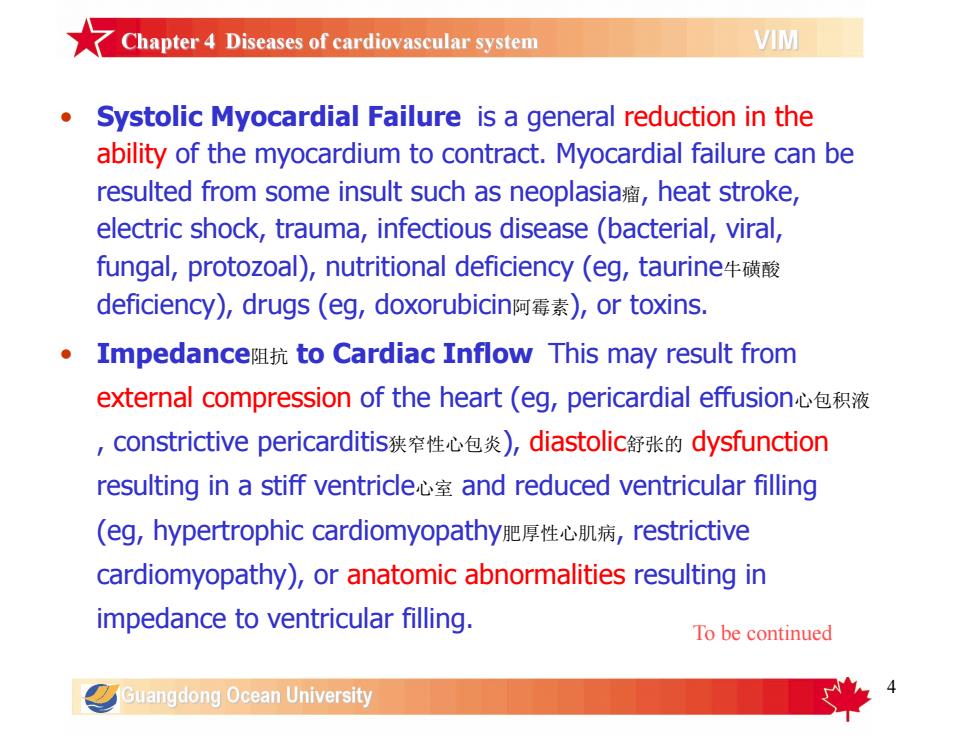
7Chapter4Diseases of cardiovascular systemVIMSystolic Myocardial Failure is a general reduction in theability of the myocardium to contract. Myocardial failure can beresultedfrom some insult suchas neoplasia瘤,heat strokeelectric shock, trauma, infectious disease (bacterial, viralfungal,protozoal),nutritional deficiency(eg,taurine牛磺酸deficiency), drugs (eg, doxorubicin阿霉素), or toxins.Impedance阻抗 to CardiacInflow This may resultfromexternal compression of the heart (eg,pericardial effusion心包积液,constrictivepericarditis狭窄性心包炎),diastolic舒张的dysfunctionresulting in a stiff ventricle心室 and reduced ventricular filling(eg,hypertrophiccardiomyopathy肥厚性心肌病,restrictivecardiomyopathy), or anatomic abnormalities resulting inimpedance to ventricular filling.To be continuedGuangdong Ocean University
4 • Systolic Myocardial Failure is a general reduction in the ability of the myocardium to contract. Myocardial failure can be resulted from some insult such as neoplasia瘤, heat stroke, electric shock, trauma, infectious disease (bacterial, viral, fungal, protozoal), nutritional deficiency (eg, taurine牛磺酸 deficiency), drugs (eg, doxorubicin阿霉素), or toxins. • Impedance阻抗 to Cardiac Inflow This may result from external compression of the heart (eg, pericardial effusion心包积液 , constrictive pericarditis狭窄性心包炎), diastolic舒张的 dysfunction resulting in a stiff ventricle心室 and reduced ventricular filling (eg, hypertrophic cardiomyopathy肥厚性心肌病, restrictive cardiomyopathy), or anatomic abnormalities resulting in impedance to ventricular filling. To be continued
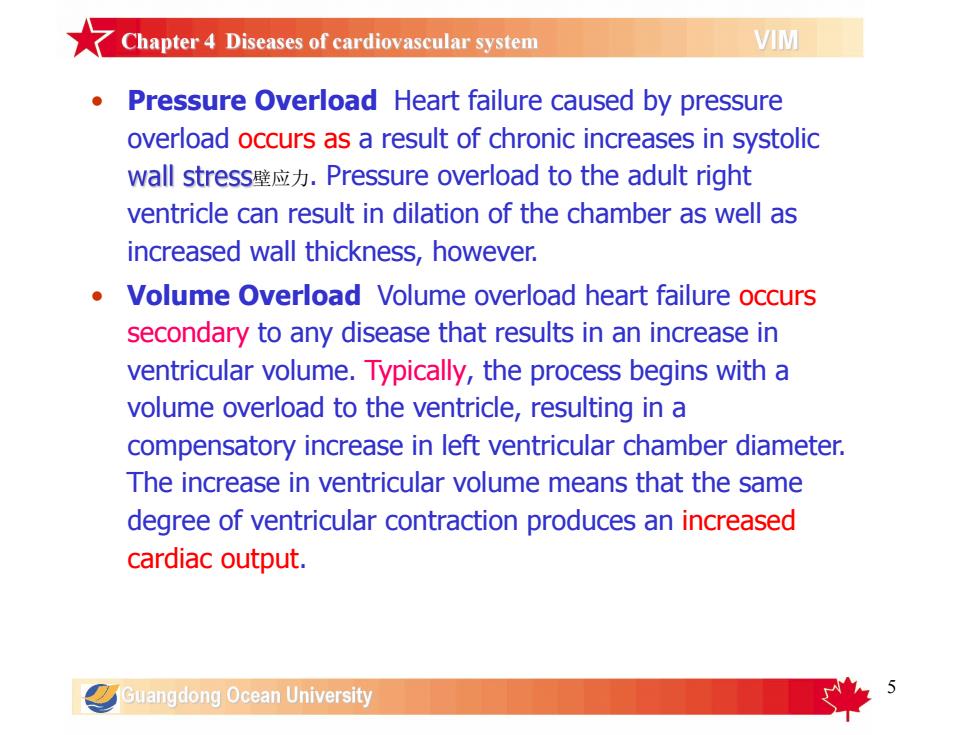
7Chapter4Diseasesof cardiovascular systemVIMPressure Overload Heart failure caused by pressureoverload occurs as a result of chronic increases in systolicwallstress壁应力.Pressureoverloadtotheadultrightventricle can result in dilation of the chamber as well asincreasedwallthickness,howeverVolume Overload Volume overload heart failure occurssecondaryto any diseasethat results inan increaseinventricularvolume.Typically,the process beginswithavolume overload to the ventricle, resulting in acompensatory increase inleftventricular chamber diameterThe increase in ventricular volume means that the samedegree of ventricular contraction produces an increasedcardiac outputGuangdong Ocean University
5 • Pressure Overload Heart failure caused by pressure overload occurs as a result of chronic increases in systolic 壁应力. Pressure overload to the adult right ventricle can result in dilation of the chamber as well as increased wall thickness, however. • Volume Overload Volume overload heart failure occurs secondary to any disease that results in an increase in ventricular volume. Typically, the process begins with a volume overload to the ventricle, resulting in a compensatory increase in left ventricular chamber diameter. The increase in ventricular volume means that the same degree of ventricular contraction produces an increased cardiac output